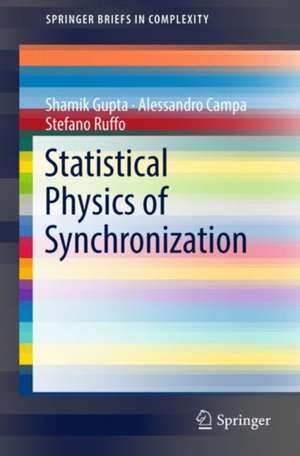Statistical Physics of Synchronization: SpringerBriefs in Complexity
Autor Shamik Gupta, Alessandro Campa, Stefano Ruffoen Limba Engleză Paperback – 5 sep 2018
This book introduces and discusses the analysis of interacting many-body complex systems exhibiting spontaneous synchronization from the perspective of nonequilibrium statistical physics. While such systems have been mostly studied using dynamical system theory, the book underlines the usefulness of the statistical physics approach to obtain insightful results in a number of representative dynamical settings. Although it is intractable to follow the dynamics of a particular initial condition, statistical physics allows to derive exact analytical results in the limit of an infinite number of interacting units. Chapter one discusses dynamical characterization of individual units of synchronizing systems as well as of their interaction and summarizes the relevant tools of statistical physics. The latter are then used in chapters two and three to discuss respectively synchronizing systems with either a first- or a second-order evolution in time. This book provides a timely introduction to the subject and is meant for the uninitiated as well as for experienced researchers working in areas of nonlinear dynamics and chaos, statistical physics, and complex systems.
Din seria SpringerBriefs in Complexity
-
 Preț: 377.18 lei
Preț: 377.18 lei -
 Preț: 377.95 lei
Preț: 377.95 lei -
 Preț: 376.59 lei
Preț: 376.59 lei -
 Preț: 377.18 lei
Preț: 377.18 lei -
 Preț: 378.54 lei
Preț: 378.54 lei - 20%
 Preț: 462.65 lei
Preț: 462.65 lei -
 Preț: 377.95 lei
Preț: 377.95 lei -
 Preț: 445.33 lei
Preț: 445.33 lei -
 Preț: 376.80 lei
Preț: 376.80 lei -
 Preț: 347.31 lei
Preț: 347.31 lei -
 Preț: 409.43 lei
Preț: 409.43 lei -
 Preț: 477.17 lei
Preț: 477.17 lei -
 Preț: 311.31 lei
Preț: 311.31 lei -
 Preț: 343.59 lei
Preț: 343.59 lei -
 Preț: 412.30 lei
Preț: 412.30 lei -
 Preț: 379.09 lei
Preț: 379.09 lei -
 Preț: 475.65 lei
Preț: 475.65 lei -
 Preț: 374.85 lei
Preț: 374.85 lei -
 Preț: 445.12 lei
Preț: 445.12 lei -
 Preț: 444.94 lei
Preț: 444.94 lei - 20%
 Preț: 323.46 lei
Preț: 323.46 lei -
 Preț: 442.62 lei
Preț: 442.62 lei
Preț: 445.49 lei
Nou
Puncte Express: 668
Preț estimativ în valută:
85.25€ • 89.23$ • 70.95£
85.25€ • 89.23$ • 70.95£
Carte tipărită la comandă
Livrare economică 31 martie-14 aprilie
Preluare comenzi: 021 569.72.76
Specificații
ISBN-13: 9783319966632
ISBN-10: 3319966634
Pagini: 119
Ilustrații: XVI, 121 p. 32 illus., 27 illus. in color.
Dimensiuni: 155 x 235 mm
Greutate: 0.2 kg
Ediția:1st ed. 2018
Editura: Springer International Publishing
Colecția Springer
Seria SpringerBriefs in Complexity
Locul publicării:Cham, Switzerland
ISBN-10: 3319966634
Pagini: 119
Ilustrații: XVI, 121 p. 32 illus., 27 illus. in color.
Dimensiuni: 155 x 235 mm
Greutate: 0.2 kg
Ediția:1st ed. 2018
Editura: Springer International Publishing
Colecția Springer
Seria SpringerBriefs in Complexity
Locul publicării:Cham, Switzerland
Cuprins
Synchronizing systems.- Introduction.- The oscillators and their interaction: A qualitative discussion.- Oscillators as limit cycles.- Interacting limit-cycle oscillators.- Synchronizing systems as statistical mechanical systems.- The features of a statistical physical description.- Some results for noiseless interacting oscillators.- The oscillators with inertia.- Appendix 1: A two-dimensional dynamics with a limit-cycle attractor.- Appendix 2: The Lyapunov exponents.- Appendix 3: The one-body distribution function in an N-body system.- Oscillators with first-order dynamics.- The oscillators with distributed natural frequencies.- The Kuramoto model.- Unimodal symmetric g(w).- Nonunimodal g(w).- Appendix 1: An H-theorem for a particular simple case.- Appendix 2: Form of the function r(K) for symmetric and unimodal frequency distributions in the Kuramoto model.- Appendix 3: The numerical solution of Eq. (2.34).- Oscillators with second-order dynamics.- Generalized Kuramoto model with inertia and noise.- Nonequilibrium first-order synchronization phase transition: Simulation results.- Analysis in the continuum limit: The Kramers equation.- Phase diagram: Comparison with numeric.- Appendix 1: The noiseless Kuramoto model with inertia: Connection with electrical power distribution models.- Appendix 2: Proof that the dynamics (3.9) does not satisfy detailed balance.- Appendix 3: Simulation details for the dynamics (3.9).- Appendix 4: Derivation of the Kramers equation.- Appendix 5: Nature of solutions of Eq. (3.32).- Appendix 6: Solution of the system of equations (3.39).- Appendix 7: Convergence properties of the expansion (3.38).
